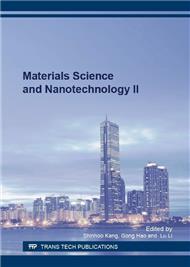p.75
p.85
p.90
p.95
p.102
p.111
p.116
p.123
p.127
Electroplating of ZnO Influenced by the Concentration of Aluminum Nitrate in the Bath
Abstract:
Electrochemical deposition of Al-doped ZnO (AZO) on the ITO glass was investigated in baths containing various concentrations of aluminum nitrate. The electrochemical and chemical reactions can be deduced by means of investigating cathodic polarization curves and time/electroplating-current curves for further characterizing structures of ZnO and AZO, and establishing growth mechanism. High-quality AZO nanorods, depositing on ITO substrate that coated with ZnO seed-layer, were utilized the electrochemical method at-1.0 V (against a reference electrode of Ag/AgCl in 3.0M KCl) in the bath of 90 °C. After annealing at 350 °C, ZnO and AZO nanorods were analyzed by field-emission scanning electron microscope (FESEM) to explore the morphology of nanostructure. The SEM image displayed that the lower Al3+ concentrations (20 ~ 60 μM) in the bath, the average diameter of nanorods decreased; while the Al3+ concentrations excessed over 60 μM, the morphology of the AZO nanorods turned into partial-area nanosheets instead of the nanorods spread. The crystal structure of the AZO nanorods were identified by using grazing-incident X-ray diffraction (GIXRD). The patterns of the Al3+ ions in the range of 20 ~ 60 μM in the bath showed that the preferred orientations were along with the [002] direction which confirmed the result of AZO nanorods well aligned in c-axis orientation, and the characterized peak (002) slightly shifted to the right suggested that Al atoms had doped into the ZnO lattice. We also adopted the X-ray photoelectron spectroscopy to characterize the elemental and chemical compositions of the AZO nanorods. XPS spectrums confirmed that the Al atoms successfully doped. Finally, for identifying the optimal boundary condition of Al content in ZnO, the nanorods with various Al concentrations were utilized via dye-sensitized solar cells (DSSC) experiment with the standard solar Simulators (AM1.5G) and J-V Measurement. We found that the AZO nanorods as the photoanode contained 2.84 at.% Al (60 μM aluminum nitrate in the bath) which performed the highest fill-factor (0.53) and the maximum efficiency (0.41%).
Info:
Periodical:
Pages:
102-107
Citation:
Online since:
August 2016
Authors:
Price:
Сopyright:
© 2016 Trans Tech Publications Ltd. All Rights Reserved
Share:
Citation:


